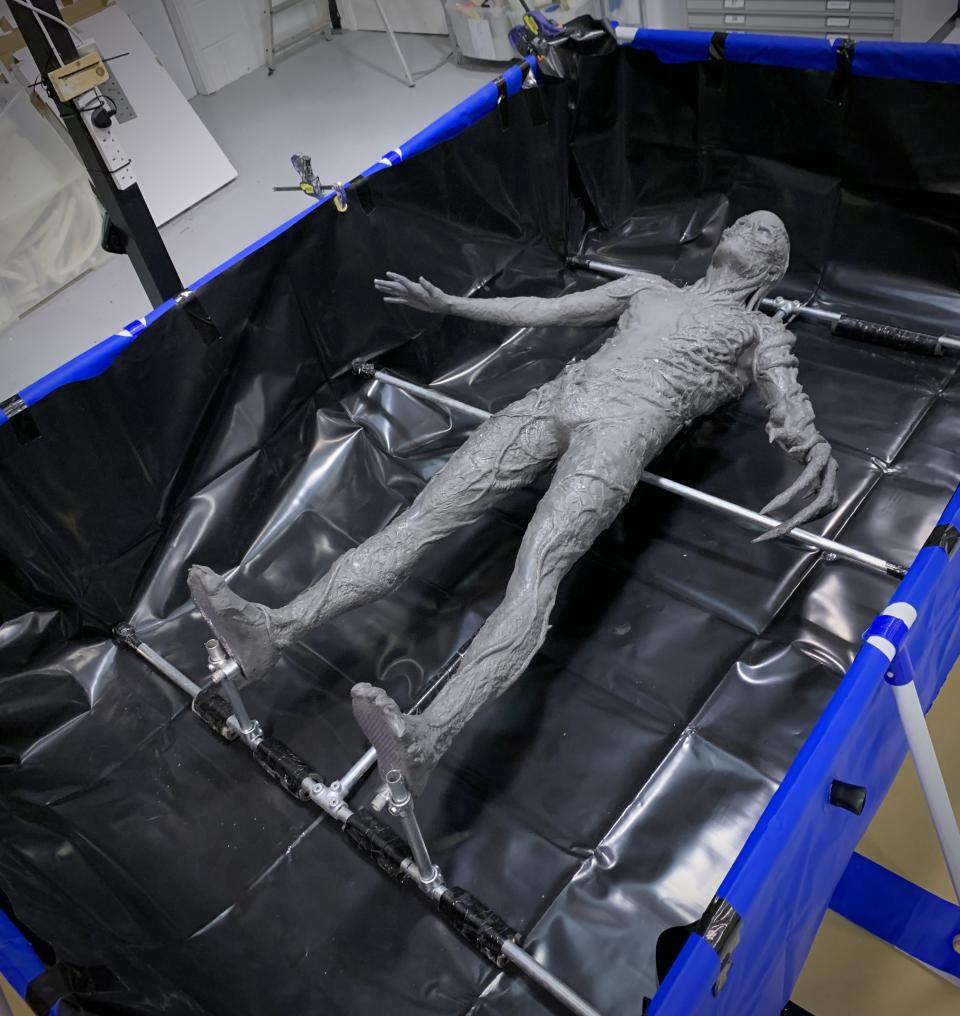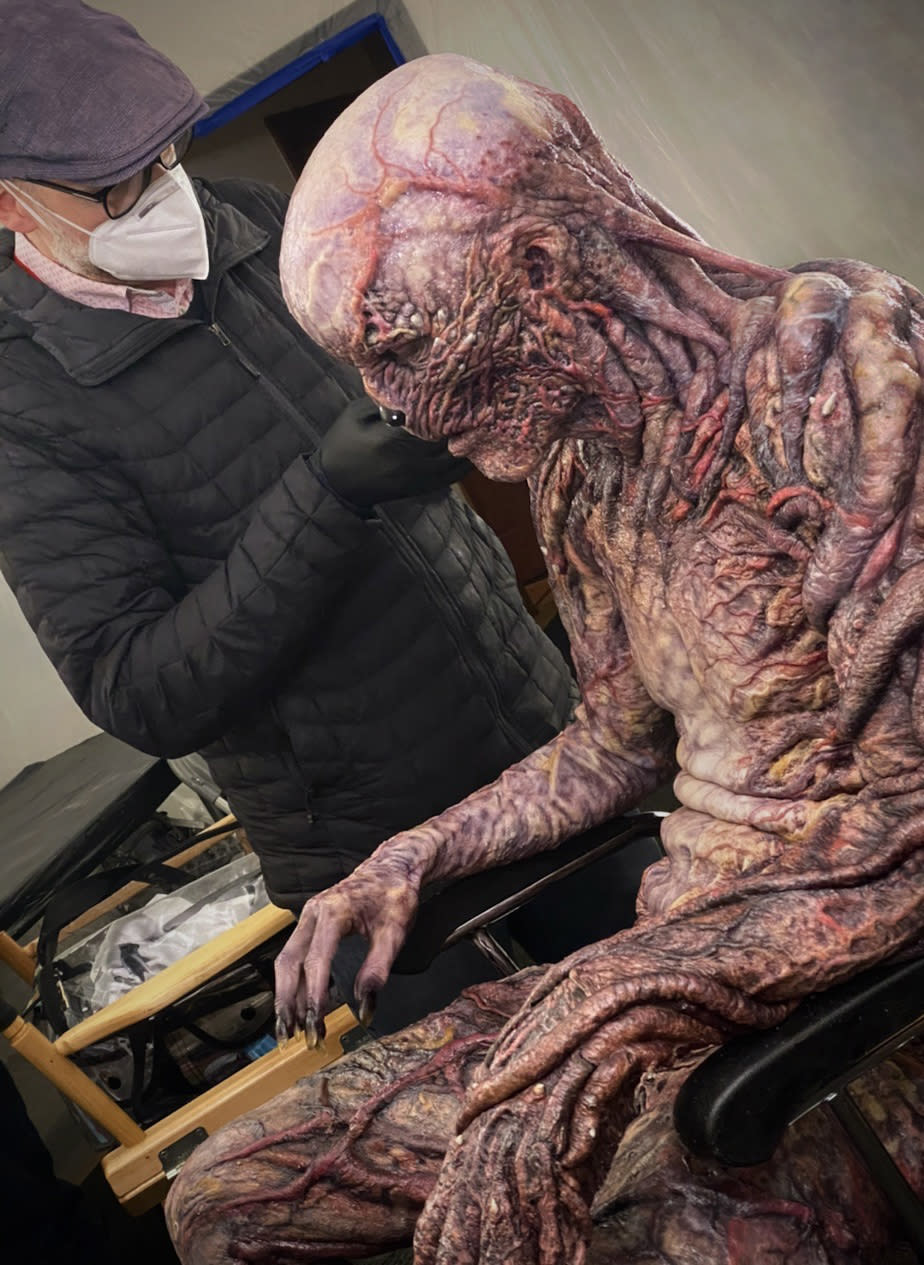How ‘Stranger Things’ Villain Vecna Was Inspired by the Night King From ‘Game of Thrones’
- Oops!Something went wrong.Please try again later.
- Oops!Something went wrong.Please try again later.

Spoiler Alert: Do not read if you haven’t watched “The Massacre at Hawkins Lab,” the seventh episode of ‘Strangers Things’ Season 4, now streaming on Netflix.
The first three seasons of “Stranger Things” saw plenty of memorable eldritch creatures terrorize the citizens of Hawkins, Ind., from the carnivorous Demogorgons to the colossal Mind-Flayer. But Season 4 introduces perhaps the most terrifying foe yet in Vecna, played by Jamie Campbell Bower as both the monster itself and as its human form Henry Creel. A “dark wizard” that stalks and murders teens struggling with depression and trauma, Vecna is the creation of BGFX, the prosthetic makeup company headed by Barrie Gower.
More from Variety
Before joining the smash Netflix hit, Gower won three Emmys for “Game of Thrones,” which saw his company produce the prosthetics for the Night King, the ice-covered leader of the White Walker hordes that threaten Westeros. When Gower got the call about working on “Stranger Things” in 2019, he was approached because series creators the Duffer Brothers were fans of his “Game of Thrones” work, and were looking to create a similar villain for the show’s upcoming season.
“With season four, they were after a new, big iconic villain,” Gower says. “They decided that they wanted their own version of the Night King, an iconic figure, and they thought ‘Well, why don’t we just contact the guys who made the Night King?'”
The design of Vecna was devised by the show’s senior concept illustrator Michael Maher Jr., who provided Gower and his team with art to base the prosthetics on. Vecna’s burned, corpse-like look draws heavy inspiration from the iconic “Nightmare on Elm Street” slasher Freddy Kruger, with the films in general serving as a lodestar for the season.
The design remained mostly consistent from the art to practical effects stage, although there were some alterations to make the form less elongated and fit a real human body. According to Gower, the Duffers were adamant that, unlike the Demogorgons or the Mind-Flayer of seasons past, the character be created almost entirely via practical effects, to create a more tangible, human presence.
The BGFX team, which consisted of about 15 to 20 people, started the process of designing Vecna by molding a full body cast of Bower, and then sculpting Vecna’s prosthetics with modeling clay. Although the process for creating Vecna was similar to the Night King, Vecna’s prosthetics were far more extensive: the Night King was mostly head, shoulders and hand makeup, while the team had to create an entire human-sized body for Vecna. After spending a month sculpting the figure, the team had to submerge the base in water to activate a soap layer between the clay and plaster of paris body, in order to make it easier to separate the prosthetic into different pieces. For the Night King and other characters, Gower’s team usually uses a dustbin of water to submerge the creation. For Vecna, the company bought a three meter square paddling pool, spent a whole day filling it with water, and left the Vecna sculpture overnight before they could separate it into distinct parts.

Courtesy of Netflix
“We’ve been running our company for about 10 years now and we’ve done some quite extensive makeup, but I think that Vecna is definitely the most extensive sized prosthetic makeup we’ve ever done before,” Gower says. “It’s the same sort of process as the Night King but much bigger in scale.”
The costume ended up being separated into about 24 or 25 different pieces, made from foam latex or silicone rubber material: a top of head piece, a chin appliance, a five kilogram shoulder piece, chest and back appliances, three separate appliances for his right arm, a foam latex right arm with chunky vines over it, a mechanical left hand created by animatronics designer Adam Kenan, three foam latex appliances per leg, two foam latex shoes and separate tendril parts glued to the body. Once the designs for the different pieces were approved, the team also had to make 25 copies of each pieces, one for every single day of the shoot, due to the way in which the prosthetics were applied to Bower every day.
“We approached this more as a full body prosthetic makeup rather than a guy in a creature suit,” Gower says. “Because he was gonna be interacting an awful lot and close up with cast, there’ll be an awful lot of movements. It was very strenuous role as well. Jamie did all of his own stunts, but we wanted the appliances to be very close-fitting due to the design of Vecna, it’s very slender and sleek. And we didn’t want any buckling in the rubber or anything like that. So almost everything is is glued to Jamie’s skin with a medical adhesive.”
Many of the appliances were purposefully designed to be very thin, especially his face coverings, to give Bower expressive facial movement. Gower’s team also avoided covering the armpits and other areas, to give him full limb movement. In order to ensure Bower would be able to go to the bathroom every day while buried under the prosthetics, the suit was designed with an undercarriage that could be buttoned on and off, while his left hand was made easy to pop on and off so he could operate a toilet.
Once filming began, Gower worked with a team of four, who would begin applying the prosthetics to Bower at 2 or 3 am every day. They timed themselves every day to try and finish the application as quickly as possible. The first day it took eight and a half hours to glue everything on and they eventually got it down to around six hours and 20 minutes. The prosthetics were pre-painted, so after everything was on, they airbrushed and inked over the seams.
“Jamie was the fifth member of our team and he was so supportive of us and we gelled very well,” Gower says. “We had a great time during the application process. We’d sit him down in the chair, Jamie would crank on some tunes, it’d usually be thrash metal or heavy metal to get into the Vecna mode. It was like this well orchestrated dance between the four of us and Jamie. The more and more we did the process, the more he knew where he needed to be at any one time.”

Courtesy of Netflix
Before Bower started filming, the makeup team would spend 10 to 15 minutes covering the prosthetics in a glossy gel, in order to give Vecna a shiny finish reminiscent of other creatures from the Upside Down. After the shoot wrapped production, the visual effects team used CGI to animate the movement of the veins and vines along Vecna’s body, removed Bower’s nose and removed his pupils from shots, resulting in the finished look seen in the show.
The majority of Gower and his team’s work was on Vecna, but they did do additional prosthetics for two other characters. The first was Hopper (David Harbour), who wore prosthetics for flashback scenes before his character loses weight in the prison he’s held captive in. The second is Victor Creel, the traumatized father of Henry, played in a meta bit of casting by the iconic Freddy Kruger performer himself, Robert Englund. Victor is a tragic man who saved himself from being murdered by Vecna by gouging out his own eyes, so Gower’s team designed the scarred eyelid prosthetics for the character in the scene where Nancy (Natalia Dyer) and Robin (Maya Hawke) meet with him in the asylum he’s held in.

Courtesy of Netflix
As an ’80s kid who grew up watching the “Nightmare on Elm Street” films, Gower was a massive Freddy Kruger fan, and wanted to become an artist who created horror film monsters. For him and many of the people on his team, working with Englund was a fanboy fantasy come to life. During the shoot in November of 2020, Gower and his team spent two hours a day applying the prosthetics to Englund, who was a seasoned pro with prosthetics.
“He’s an actor who probably had more prosthetics glued to him than anyone else,” Gower says. “We couldn’t get away with anything because he knew all the tricks, he knew everything. But we just sat there and he just like, gave us all these anecdotes and all these stories about his career, and we were like kids in a candy store. It was a dream come true.”
Best of Variety
Sign up for Variety’s Newsletter. For the latest news, follow us on Facebook, Twitter, and Instagram.

